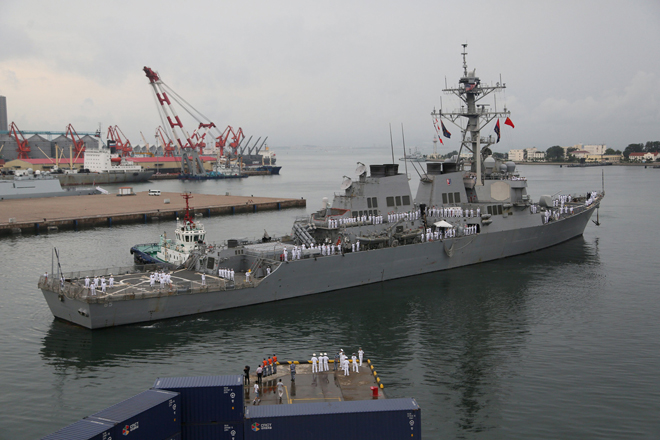
USS Benfold, a guided-missile destroyer, arrives at a port in Qingdao, Shandong Province, China. — Reuters photo
BEIJING/TOKYO: As China diplomatically confronts the United States and South Korea over new missile defences and intensifies pressure on Japan at sea over disputed islets, Beijing is signalling it is prepared to stand its ground on two key regional fronts.
Mainland analysts see little immediate chance for an easing of tensions now roiling across Northeast Asia, saying a rising China is showing it is keen to shape its own battlefield despite fresh threats.
“This action is China saying to the world that it has the ability to fight two regional conflicts on its doorstep,” said Ni Lexiong, a naval expert at the Shanghai University of Political Science and Law.
“If is actively making provocations in our South China Sea, then in the East China Sea, on its doorway, it will face a little pressure,” Ni said.
Beijing’s claims to much of the South China Sea were invalidated last month in an emphatic ruling by an arbitration court in The Hague in a case brought by rival claimant, the Philippines.
The region’s deepening fault lines after the ruling were exposed at the weekend as a fleet of Chinese coast guard and fishing vessels sailed near Japanese-controlled islets in the East China Sea. Japan warned China on Tuesday ties were “deteriorating markedly”.
Tokyo worries that Chinese control of the South China Sea, through which much of the oil it imports is shipped, threatens its national security and takes Beijing a step closer to extending its influence into the Western Pacific.
Japan has cranked up assistance recently to two countries who have territorial disputes with China in the South China Sea, the Philippines and Vietnam.
Japan’s administration of the disputed islands it calls Senkaku, and China calls Diaoyu, puts them under the long-standing security treaty between Washington and Tokyo.
Kevin Maher, a Washington security consultant and a former head of the State Department’s Office of Japan Affairs said he thinks China is trying to warn Japan not to interfere in the South China Sea after Tokyo strongly endorsed the Hague ruling.
China “wants to see how far they can push until they get pushed back,” Maher said.
“Their ultimate goal is hegemony in the South China Sea and the East China Sea.”
At the same time, South Korea’s presidential Blue House rebuked China for criticising Seoul’s decision to deploy an advanced U.S. anti-missile defence system, urging Beijing to instead work harder to rein in North Korean nuclear and missile tests.
While China has grown increasingly irritated over North Korea’s nuclear and missile tests, it vehemently opposes South Korea’s decision to host a Terminal High Altitude Area Defence (THAAD) unit with the US military.
Beijing sees THAAD’s radar system, capable of peering into China’s military installations, as part of Washington’s strategy of containment, with the two powers clashing over China’s possible militarisation of rocks and reefs in the disputed South China Sea.
Recent satellite photographs show China appears to have built aircraft hangars that could accommodate any fighter jet in its air force on artificial islands it is building on reefs in the South China Sea, according to the Center for Strategic and International Studies (CSIS), a Washington think tank.
THAAD’s location was announced a day after The Hague court ruled against China’s claims in sea, through which some US$5 trillion of cargo passes annually. South Korea and the United States have said THAAD would only be used in defense against North Korean ballistic missiles. — Reiter
